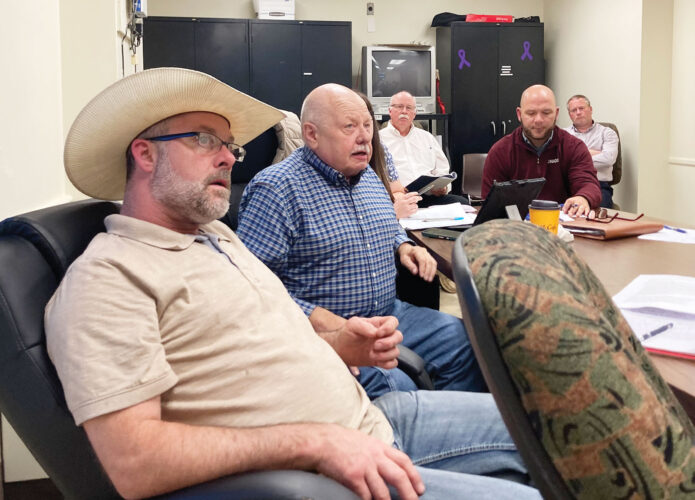-
A screen from the Zoom presentation shows water rate recommendations from Great Lakes RCAP, a financial, managerial and operational group that specializes in water systems. Information from the study will be available to the public in a presentation at the Oct. 20 Marietta City Council meeting.
(Photo by Nancy Taylor)
-
Marietta City Council and administration members viewed a Zoom presentation of the nearly-completed water rate study that has been worked on since its initiation in February. The study was prompted by the necessity of an upcoming major overhaul of the city’s water treatment system.
(Photo by Nancy Taylor)
A screen from the Zoom presentation shows water rate recommendations from Great Lakes RCAP, a financial, managerial and operational group that specializes in water systems. Information from the study will be available to the public in a presentation at the Oct. 20 Marietta City Council meeting.
(Photo by Nancy Taylor)
A conference room full of Marietta City Council members, elected officials and administrators got the first formal presentation of the Marietta water rate study draft results at Tuesday’s Water and Sewer Committee meeting.
The presentation via Zoom allowed those in Marietta to interact with representative Todd Brandenburg of Great Lakes RCAP, a Rural Community Action Program, along with the Ohio EPA and others involved in consulting on the project.
The city contracted with Great Lakes in February to analyze extensive Marietta water system data and create a mathematical model to guide city leaders through the coming years when they plan a major rebuilding of Marietta’s water treatment system. Brandenburg said his organization is not an engineering firm. He described it as a “financial, operational, managerial” group.
City officials and staff have spent significant time and effort in working with Great Lakes and providing the raw data, from previous years’ revenues and expenditures, growth or decline in the customer count, proposed construction and debt service costs, anomalies and their possible effects on future rates, and many other factors.
The idea is to refine the data to the point that a “typical” year can be constructed and then used as the base to project the future. The cooperation from the city and its timely response in gathering all the information has been great, Brandenburg said. Marietta City Engineer Joe Tucker also thanked city staff for its work, and described all involved as “very patient.”
Marietta City Council and administration members viewed a Zoom presentation of the nearly-completed water rate study that has been worked on since its initiation in February. The study was prompted by the necessity of an upcoming major overhaul of the city’s water treatment system.
(Photo by Nancy Taylor)
Brandenburg also emphasized that the result — the prediction of how the future will look, based on historical data — is exclusively based on Marietta and the conditions at the time the study was conducted. It’s not a rate survey, where surrounding communities or similar population groups were compared to Marietta in order to draw conclusions.
“We believe that comparing you to a similar city is not valid,” he said.
Tucker said Marietta currently has 5,660 residential water accounts, 786 commercial ones, 41 in the industrial/government category, and 64 in the “other” category, which includes schools.
Brandenburg described the mathematical model as a living document that can be updated with actual operating data as changes arise, such as fluctuating inflation rates or wage increases. Another example is the cost of electricity, which is going to increase with the move to the reverse osmosis water treatment method.
There were three “KPIs”, or Key Performance Indicators, that Brandenburg said he used in assessing Marietta’s system. The first is non-revenue water, or water loss, as it was commonly labeled in prior times. The Ohio EPA cites a desirable benchmark as being a loss of 15% or lower. Marietta’s loss in this area is around 11%. The second performance indicator is a cash fund or reserve balance of 150 days of operating expenses, a standard cited by the City of Marietta. The third indicator is how median household income is affected by rate increases, and numerous funds cite a 2% as the limit of change in rates affecting affordability. That is based on an “average” customer using 4,500 gallons of water or 600 cubic feet.
The conclusions for Marietta show little to no growth in customer base, according to historical data. The study’s projected customer counts should remain the same for years 2013-2030. Overall water sales have been declining the past three years, as have overall production numbers. The average decline there is less than 0.5%.
The rate study recommends rate increases for that “average”customer that would run from 2023 through 2030:
¯ 2023, $1.32
¯ 2024, $1.55
¯ 2025, $1.98
¯ 2026. $3.32
¯ 2027, $3.61
¯ 2028. $3.81
¯ 2029, $3.77
¯ 2030, $3.67.
Brandenburg said the affordability factor on those rate increases tops at 1.7%, below the 2% performance indicator recommended limit. The figures are based on 2020 census data, the most current available at this time.
Tucker reviewed the timeline for switching to a new, single, reverse osmosis water plant: possible loan application submitted in November, followed by loan approval in early December, loan awarded in January, funds in place by March. The new plant would not be operational until mid-2025. The first loan payments would be due in 2026.
Council member Bret Allphin, Water and Sewer Committee Chair, said members of the public can view a pared-down version of the Zoom presentation on the water rate study during the regularly scheduled council meeting on Oct. 20. There will be other public meetings scheduled in November, he said. Allphin also said he would make himself accessible to those who want to contact him.
